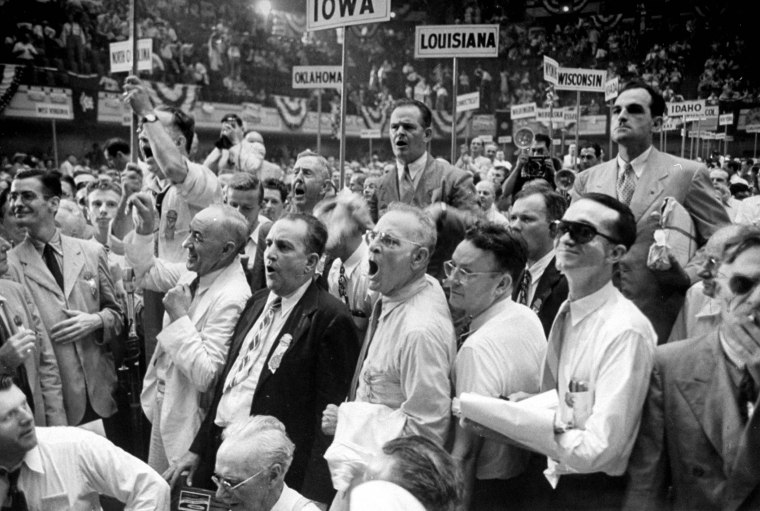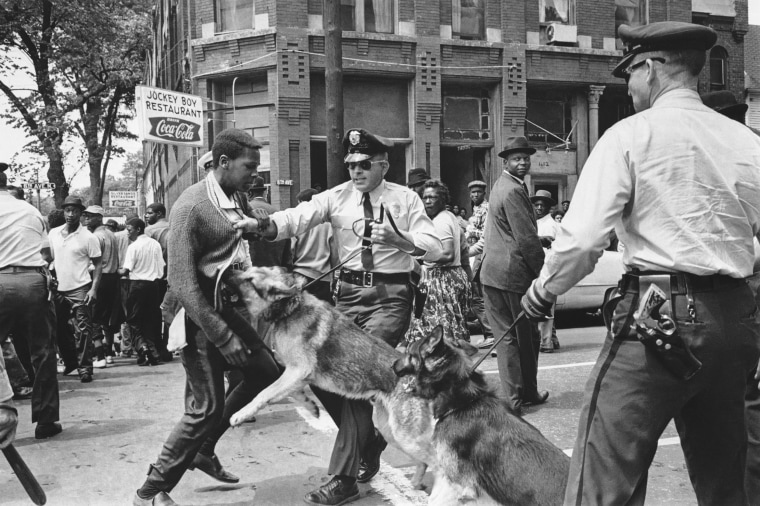On the ashes of the attack on the U.S. Capitol and the conflagrations we can expect going forward, one of the most pressing questions we face is how to marginalize the pro-Trump rioters who terrorized the seat of government on Jan. 6 and restore the public's faith in democracy. History can be a guide, and in this case, those who used violence to oppose the civil rights movement not only provide a good comparison but also reveal much about how we got to this present moment — and what we need to do differently this time.
It's no accident that the mob carried Confederate flags and sought to nullify the votes of hundreds of thousands of African Americans in cities such as Atlanta, Philadelphia and Milwaukee.
The white Southerners who formed the "massive resistance" ranged from the uneducated to Southern elites. But in response to Brown v. Board of Education, the 1954 Supreme Court decision desegregating schools, they banded to deny Black people political power and maintain the post-Reconstruction Jim Crow order.
There are loud echoes between those who joined the massive resistance and the insurrectionists who stormed the Capitol. It's no accident that the mob carried Confederate flags and sought to nullify the votes of hundreds of thousands of African Americans in cities such as Atlanta, Philadelphia and Milwaukee by baselessly declaring that President Donald Trump was the true victor of the presidential election. Their hate-filled attacks on the federal government for allegedly trampling their freedoms hark back to the white supremacists' invocation of "states' rights" as justification for violently opposing desegregation by the federal government.
And like the Capitol marauders who were aided by members of Congress, such as Republican Reps. Mo Brooks and Paul Gosar, who gave verbal encouragement to the rioters, the cause of massive resistance found support from diehard segregationists in Congress. Meanwhile, baseless conspiracy theories that communists and outside agitators controlled the civil rights movement also align with Trump-fueled QAnon theories that Democratic pedophiles acted as a fifth column inside the federal government to take down the president.
The failure to fully stamp out the so-called massive resistance is contributing to the insurrection we see today. Broadly speaking, anti-civil rights activists and leaders followed three different paths in the decades after the heyday of civil rights: A handful faced prosecution, a few recanted, and most continued on with few consequences. The first two paths led to some dissipation of animosity and slowed momentum for white supremacists, but the most common outcome — the lack of any action — shows what can happen if we ignore or cultivate the forces of hatred.
Some white supremacists ended up paying a considerable price for their crimes in the civil rights era, albeit decades after the fact. Byron De La Beckwith, for instance, was convicted 31 years after he murdered NAACP activist Medgar Evers in 1963, while another white supremacist was sent to jail more than 40 years after the murders of three civil rights workers in Philadelphia, Mississippi.
For those charged at the time of their crimes, justice was conspicuously lacking. In one famouus case, a KKK member who in 1963 bombed the 16th Street Baptist Church in Birmingham, Alabama, and murdered four Black girls was acquitted of murder and received a mere six months in prison. (He was eventually convicted of murder in 1977.)
These miscarriages of justice were enabled by state and local authorities who sympathized with and in some cases encouraged the most rabid leaders of massive resistance and shielded white supremacists guilty of these crimes from consequences. Police forces, led by the likes of Birmingham Public Safety Commissioner Bull Connor, joined with all-white juries and political leaders who owed their power to a still-thriving white supremacist movement to resist prosecution for the guilty.
At the federal level, presidential administrations tended to undermine the cause of civil rights. This abdication of responsibility sent a message of impunity for these race-based crimes and likely contributed to a lack of pressure for ringleaders to renounce their views and change their ways. Most notably, Alabama Gov. George Wallace pledged "segregation now, segregation tomorrow and segregation forever" in his 1963 gubernatorial inaugural address. After being shot and paralyzed during his 1972 campaign for the Democratic presidential nomination by a gunman seeking fame, however, Wallace subsequently apologized for his rhetoric and won forgiveness from the civil rights icon John Lewis.

But these late-in-life conversions were the exception and probably had scant impact on the arc of America's recent history. Arguably the most common path for anti-civil rights white supremacists was a quiet defiance until the end, and this was hardly confined to the South, as opposition to desegregation inflamed politics across the country.
For these committed racists, the course involved eschewing the explicit language of white supremacy by employing code words ("welfare queen") rather than the most familiar racist expressions that had become more culturally toxic — indicating some shift in what was acceptable within the larger society — while seeking to chip away at policies like minority voting rights and affirmative action.
They most often found a home in the Republican Party after having abandoned Democrats because of President Lyndon B. Johnson's backing for civil rights legislation. Some post-civil rights extremists, such as former KKK leader David Duke, ran for office and won seats in state legislatures, while former Dixiecrat presidential nominee Strom Thurmond had a decadeslong career as a U.S. Senate powerhouse. Sen. Jesse Helms of North Carolina and GOP national chairman Lee Atwater pioneered post-civil rights race-baiting through campaign ads.
Their success shows the enduring support for racist views and how, by using racism as a weapon, they fed these views in the aftermath of the civil rights movement. It's not hard to connect the politics of Helms and Atwater to the us-against-them racist appeals of Trump to his white supremacist supporters.
But while Trumpism draws heavily on the legacy of massive resistance to the civil rights movement, what makes it uniquely dangerous, as the Capitol riot illustrates, is that a president has sanctioned it through four years of rhetoric and policies. In the post-civil rights era, no president has been as overtly racist through words and policies as Trump.
While Trumpism draws heavily on the legacy of massive resistance to the civil rights movement, what makes it uniquely dangerous, as the Capitol riot illustrates, is that a president has sanctioned it.
This time we need to pursue a course of relentless accountability for every person who invaded the Capitol. Above all, we need to convict those responsible for the murder of a Capitol Police officer, as well as Trump, Rudy Giuliani and Donald Trump Jr. for inciting the insurrection in the first place.
It is far too early to tell whether the arrests so far will bring the country solace. Elements of the police and federal law enforcement that appear to sympathize with the rioters seemingly permitted them to enter the building. Federal officials, meanwhile, waited days to brief the public and, so far at least, have not charged rioters with the most serious offenses, such as sedition.
The forces of massive resistance that entered the Republican Party's bloodstream after the 1960s need to be uprooted. Only then can the United States achieve some measure of unity and healing in the wake of the pro-Trump mob's terrorist attack on the Capitol.



